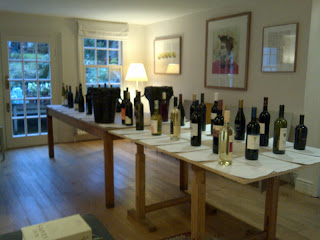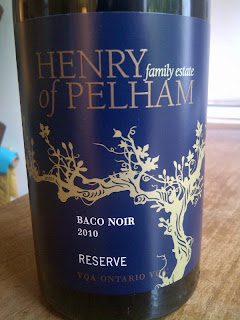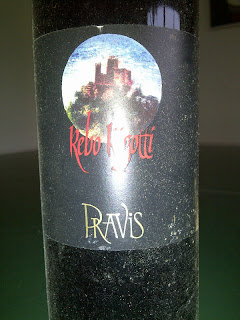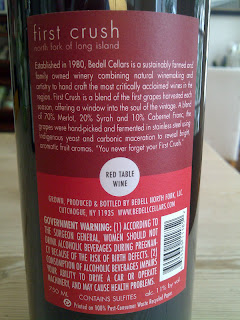Last month we were able to taste an eclectic rat-bag of 36 wines grouped together under the banner "North". These consisted of whites and reds from Germany, Canada, Switzerland, Italy/Trentino-Alto Adige-Friuli, Austria, Hungary and England as well as New York (Brooklyn!) and France/Savoie.
There were some interesting grape varieties on show including several hybrids conceived for cold climates (Andre, Cabernet Dorsa, Cabernet Mitos, Garanoir, Kerner, Rebo, Baco Noir, Regent), some obscure to very obscure naturally occurring varieties (Blauer Wildbacher, Cassetta, Cordenossa, Cornalin, Eyholzer Roter, Gringet, Resi, Negrara, Persan, Zierfandler as well as some unloved varietis such as Portugieser (from Germany, Italy and Hungary) and Vernatsch/Schiava. There were also a couple of maistream varieties; Schwarzriesling (Pinot Meunier), Samtrot - a clone of or maybe just a synonym for Pinot Meunier and Savignin going under that name and "Heida" in Switzerland.
Lastly there were a couple of oddities including an Orange wine from Chardonnay and Sauvignon Blanc produced with New York grapes in Brooklyn apparently and a pair of Uhudlers (a white and a red) from Austria.
The result of this tasting was for us a big number of surprises, both good and bad. It has to be said that quite a lot of bottles didn't seem to shine as much as they might have due to having been kept a year or two too long, probably in less than ideal conditions. There were also a number of wines which improved on having been left open for a day or more following the tasting. So we have arranged the wines into four categories;
Positive surprises
Negative Surprises
Wines we had enjoyed in the past and which disappointed on this occasion
Wines which improved with being left open for a further day or more
For us and for many others the Chanton Visp Resi was one of the most positive surprises. The very essence of a pure Alpine wine. Coming from a grape which has been rescued from extinction by the wonderful people of Chanton Visp who have also brought us several other such revivals, Resi stands for everything we applaud.
Next, we have to mention two real surprises in the sense of us having been ready to put money on the opposite outcome;
So flavousome and powerful, surprise and frankly disbelief greeted this wine from the Ahr valley; how was it possible in this are renouned for its light pinot noirs? Obviously a successful hybrid. It's cousin, Cabernet Dorsa did not reach these heights.
For us the Canadian Baco Noir Reserve from Henry of Pelham was a rich red we kept on coming back to. H of P seem to have avoided the sheer wierdness of Baco Noir - not entirely unpleasant but strange nonetheless and come up with a thoroughly enjoyable wine perhaps for Thanksgiving or Christmas or any time really. So meaty you could almost dispense with the food altogether.
Regent was one grape we had regretted planting in our small experimantal vineyard in the Thames Valley. English growers had subsequently warned us it was only good in a blend and then only in small quantities to give colour. Our only experience of a 100% Regent bore this out entirely so we were amazed at this bottle which despite having had the poor treatment which did for some less robust wines in this tasting was posively bursting with health and ripe fruit.
 |
We has struggled with the Savignin of Jura. All the raves about its nuttiness and rancio flavours had left us thinking there must be something wrong with us. Here were two very approachable Savignins - Heida being a Swiss synonym for the grape. We hope to learn to love the Jura Savignin one day as we love so many other wines from that reagion but meanwhile these will do with the Canadian version, despite the gimmicky label being a worthy contender.
The Negative surprises just about balanced the positive ones;
The most positive thing anyone had to say about Emilio Bulfon's Cordenossa was that it had a nice label. Strange because Bulfon is another of our heroes having brought back numerous Friulian varieties from the brink, all of which we have enjoyed so far. This was difficult to drink but none of the experts suggested there might be anything wrong with the bottle.
We have to include both Uhudlersunder this heading; difficult to describe which was more unpleasant. Perhaps that is a compliment of sorts to the different winemakers.
The story behind Uhudler is interesting. When phylloxera struck it seemed for a moment that European varieties were finished and wine would have to be made with American varieties in the future. This was presumably a short time before the idea of grafting onto American rootstocks made the planting of Concord, Elvira, Noah and Ripatella and the like unnecessary. A few vestiges of the unsuccessful solution have remained, one of them being Uhudler. An Austrian friend tells us there was a vogue for this as a cheap party wine for young people until the government banned it in the wake of the Anti-freeze scandal. The wine was innocent but the measure was effective. Today, despite an cheerful website listing a surprisingly large number of producers still active, the wines ramain a local phenomenon and on this showing, understandably so, gaining - unanimously - the booby prize of all tasters. Nevertheless there was something poignant about these bottles, struggling on in the face of adversity. They might have been the norm if no other solution to the phylloxera disaster had been found.
Under the heading of wines we knew and had enjoyed in the past were the following which unaccountably disappointed on this occasion
Let's be clear, Pravis's Negrara is a totally delectable wine and Negrara is a thoroughly delicious grape deserving of much greater appreciation.
Rebo is also better than happened to be the case on this occasion.
Wines which disappointed initially but were unaccountably tranformed by an inordinate amount of air contact included this Samtrot. Some say Samtrot is a clone of Pinot Meunier, some that it is just the word they use for this variety in Baden Wuerttemberg. Grafen Neipperg who also own Chateau La Gaffeliere in Saint Emilion and many other important properties have made this excellent if unwilling example.
Cassetta had been a major discovery for us but this very bottling 2 years on just wasn't the same. The Blauer Wildbacher, German Dornfelder, the two Garanoirs the Gringet, the Persan and the Schwarzriesling (Pinot Meunier) also failed to shine. We thought the English Dornfelder stood out against its German cousin though. Again, it may have been the age difference that told, the former being 2009, the Gribble Bridge being NV and most probably younger.
The only Orange Wine seemed on the day of the tasting of no redeeming social value to quote Robert Parker (in another context). Yet returning to this cute bottle a day or two later we found social value aplenty which certainly redeeemed the impression on day 1.
For the rest, we can say that whatever advantages the Czech Lemberger/St. Laurent crossing Andre gives the grower, it is unlikely to become a favourite withpublic, pleasant enough though it is. Our Cornalin was OK but not as good as some in our experience and the Humagne Rouge which is a synonym for Cornalin in any case was decidedly inferior. The two Kerners, Eisackertal in the Alto Adige and the other from Worcestershire, England showed the range this grape is capable of.
We have been promised another tasting in June. This time the theme is "South". Among the mostly Meditteanean wines will be such rarities as Bouquet (from Bulgaria), Chenanson, Corinto Nero, Moravia Agria, Negoska, Nibio, Palagrello Bianco, Rome Blanco, Rossara, Rossese, Sauvignon Rosso, Subirat Parent, Tinta Romeand others.
List of tasting 1.2.13 "North"
1. Winzervereinigung Freyburg-Unstrut, ANDRE 2009, Saale Unstrut, Germany. 12%
2.
Henry of Pelham Baco Noir Reserve, 2010, VQA Ontario,
Canada.13.5%
3.
Strohmeyer, BLAUER WILDBACHER 2002, Neuberg, Weststeiermark,Austria.
13%
4.
Weingut Hirschhof, CABERNET DORSA, 2009, Rheinhessen,Germany.
13%
5.
Schlosshof, Dernauer CABERNET MITOS, 2006 Ahr, Germany.
13.5%
6.
La Cadalora, Majere CASETTA 2005, Rosso Vallagerina, San Margherita di Ala,
Trento, Italy.
13%
7.
Fam. Pfeiffer Uhudler CONCORD, RIPATELLA,
Eltendorf,
Austria.
12.5%
8.
E. Bulfon CORDENOSSA, Valeriano, Friuli, Italy.
13.5%
9.
H. Badoux, CORNALIN 2009, Aigle, Valais, Switzerland.
13.5%
10.
Juliusspital Iphoefer, DOMINA, 2007 Franken, Germany.
12.5% (corked - withdrawn)
11.
Biddenden Gribble Bridge DORNFELDER, Kent, England.
12%
12.
Kollmann-Lex, DORNFELDER 2009, Mosel, Germany.
12.5%
13.
Chanton Visp EYHOLZER ROTER 2006, Vispertal, Valais, Switzerland.
11.4%
14.
Domaine du Paradis GARANOIR 2007, Satigny, Switzerland.
13%
15.
H. Badoux, GARANOIR 2009, Chablais, Aigle, Valais, Switzerland.
13%
16.
Dominique Belluard, Les Alpes, Cepage GRINGET 2010, Savoie, France.
12%
17.
Oriou Curare HUMAGNE ROUGE Chamoson, Valais, Switzerland.
12.5%
18.
Suedtirol Eisacktaler KERNER 2011, Klausen Italy.
14%
19.
Astley Veritas Domain J, KERNER, Worcestershire. 2009. England.
12%
20.
Pravis NEGRARA, 2008, Vigneti delle Dolomiti, Trento, Italy.
12.5%
21.
Domaine St. Germain PERSAN, 2009, Savoie, France.
12%
22.
Deutzerhof ‘Alfred C’ PORTUGIESER, Ahr, Germany.
12%
23.
Casata
PORTOGHESE, Montfort, Trento, Italy.
11.5%
24.
Hummel
PORTUGIESER, 2010, Villany,
Hungary.
12%
25.
Pravis REBO RIGOTTI 2007, Vigneti delle Dolomiti, Trento, Italy.
13%
26.
Weingut Hirschhof REGENT 2009, Rheinhessen, Germany.
13%
27.
Weingut Schlosshof REGENT, 2009 Ahr, Germany.
12.5%
28.
Chanton Visp, RESI 2006, Vispertal, Valais, Switzerland.
12.5%
29.
Oliveira Vineyard ‘Megalomaniac’ Eccentric SAVIGNIN, Niagara Peninsula, Canada.
12.9%
30.
Giroud
HEIDA (Savignin), 2009 Chamoson, Valais, Switzerland.
13.2%
31.
Grafen Neipperg SAMTROT Barrique, 2007, Wuerttemberg, Germany.
14%
32.
Cleebronn & Gueglingen SCHWARZRIESLING 2009, Wuerttemberg, Germany.
13%
33.
Fam. Johann Holler Uhudler ELVIRA, NOAH Eltendorf, Austria.
11%
34.
Untermoserhof St,
Magdalena VERNATSCH (SCHIAVA), 2011, Bolzano,
Sudtirol,
Italy.
13%
35.
Freigut Thallern ZIERFANDLER 2005 Messwein, Gumpoldskirchen, Austria.
14%
36.
Red Hook Winery ‘Vipolze’ 2010 Orange Wine, CHARDONNAY & SAUVIGNON BLANC,
North Fork Long Island ‘Product of Brooklyn, NY, USA.
12.4%































































